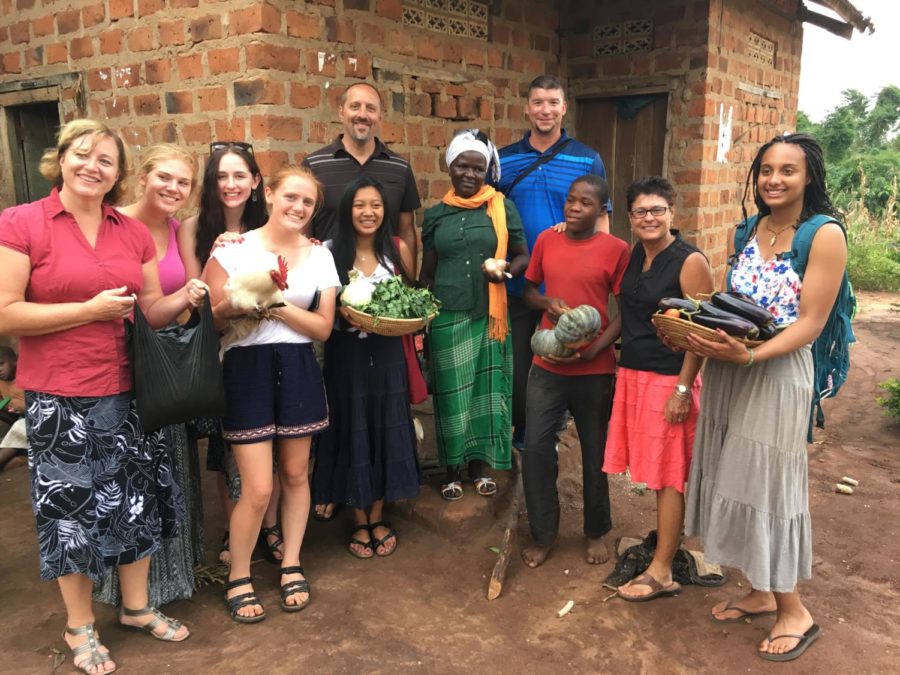Opinion: VHHS service trips avoid several pitfalls of ‘voluntourism’
VHHS students and staff take a picture with local Ugandan produce.
According to the United Nations, hunger and malnutrition are the number one health risk worldwide, and about 10 people are killed a day from explosives and landforms. The world is riddled with injustices— things seemingly fixable yet still present in our society.
One particular avenue people take in an attempt to fight the injustice on behalf of others is visiting other countries and partaking in service projects, often referred to as “voluntourism.” Unfortunately, instead of improving the lives of people, voluntourism often negatively affects the economy and infrastructure of communities.
According to Daniel Guttentag from the University of Waterloo, sometimes these volunteers who come to participate in service projects are actively taking the job away from a local worker. They build infrastructure that may be unstable or unsafe because they have to knowledge of construction. Building a school for a community is nice, but it would be much more beneficial to the community if you simply gave the community a donation.
As voluntourism grows in popularity, orphanages are stealing children with a parent in order to gain donations from volunteers, according to UNICEF. In Nepal, 85 percent of children in orphanages have at least one living parent. These children develop connections to volunteers and struggle with abandonment issues when the volunteer leaves.
VHHS sends a group of students to our sister school in Uganda every two years. The trip focuses on connecting the Vernon Hills students to the students in Uganda, and while some students may look at that as a form of voluntourism, I do not think it is.
Cassie Pappano (12), who went on the trip in 2017 as a rising junior, explained that the Uganda trip avoids the pitfalls of voluntourism.
“I know why students at our school might think COVE is an example of voluntourism, but I would disagree with that statement,” Pappano said. “When the kids go over there, we are actually doing work for COVE; we’re not there just to visit the kids.”
Ms. Tolva, the librarian, participates in planning the trips. She explained that the Uganda trip is different than just going to a place and acting like you care about the people.
“We have this 11-year relationship with [COVE], and so I think it goes beyond surface-level connection,” Ms. Tolva said.
It is clear that VHHS’s work with COVE does not fall under the category of voluntourism. This is mainly because every building that was constructed was built by local workers, simply with the money donated by the Vernon Hills community.
VHHS students partake in simple projects like retouching paint in order to save the school money. They also interview students to strengthen the connection between them and their individual sponsor who pays for their schoolings. While the Uganda trip may have some elements of voluntourism like painting to save the school money, ultimately it goes beyond that because of the long term relationship being established.
Similar to the Uganda trip, VHHS staff members are currently planning a student trip to Thailand, set for Spring Break of 2020, which includes a service project element.
Ms. Baranyk, Social Studies teacher, who is heading the trip, explained that the students will get the opportunity to fully immerse themselves into the Thai culture through the company Rustic Pathways. They are staying in a resort owned by Rustic Pathways in a rural village.
One of the service projects they plan on doing is building homes for the elderly in the community. In order to not interfere with the local economy, Rustic Pathways also hires local workers to help with the more involved work.
At first glance, this may appear to be basic voluntourism, but the Thailand trip is ultimately about learning about the Thai culture. According to Ms. Baranyk, Rustic Pathways has established a multi-year relationship with the community they are going into.
“We’re there really to learn from the community,” Ms. Baranyk said. “While we’re there to help contribute and give back to the community, I think part of that is also that we’re going there to learn from them and learn from the population and to understand Thai culture.”
Even though VHHS doesn’t have a personal connection with the community the trip plans to visit, at least the company they are going through has that established relationship to ensure no harm is done.
Voluntourism is multi-faceted. We, as Westerners, need to be conscious as to how we go about attempting to make change in underprivileged areas. In most cases, donating our time is not as effective as donating money. If you are going on a trip to a new cultural destination in hopes of making a difference, make sure you are establishing a true connection and are truly there to help the local people.

